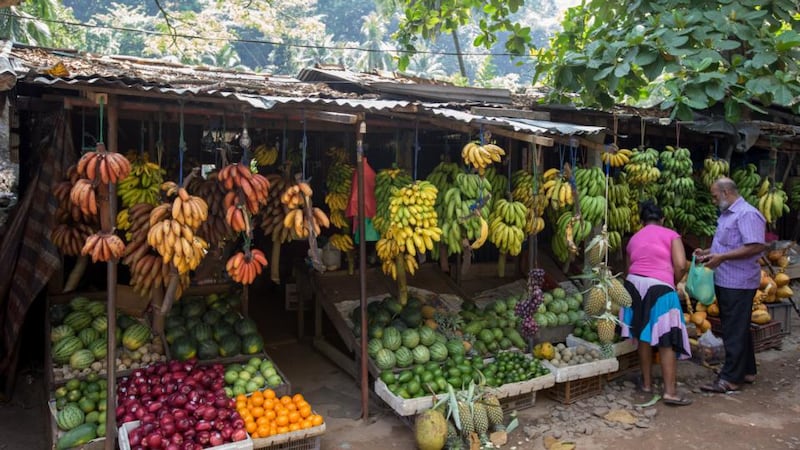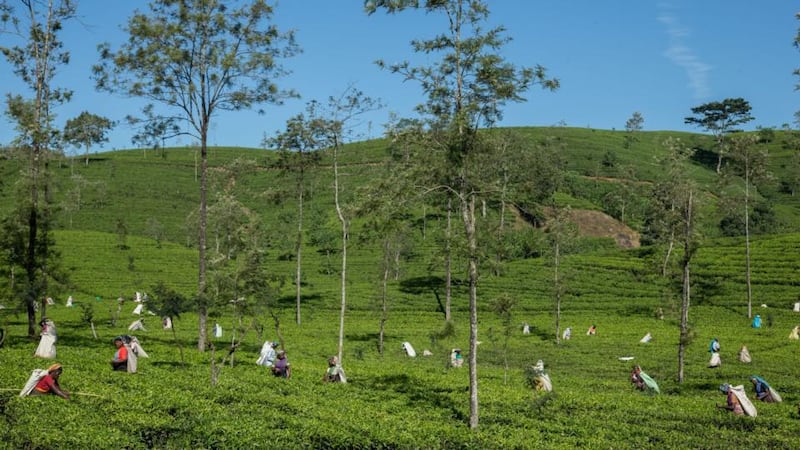The man in the khaki vest slurped noisily from his cup, descended briefly into scowling meditation, spat the contents into a sink and then unleashed a torrent of approving descriptors, lavishly rolling his r’s along the way: “No foreign taste, very refreshing, robust, strong tannins, a tingly sensation at the end of the tongue – good show!”
I sipped as well and nodded gravely, thinking: right, but it's still tea. Granted, it was excellent tea, cultivated just outside the Norwood Estate processing factory where we stood, surrounded by whirring machines and immense bags stuffed with tea leaves.
Here, near the town of Hatton, in the alluring hill country of Sri Lanka, some of the finest tea in the world is grown at an elevation exceeding 1,200 metres. And as Andrew Taylor, the vest-clad Norwood resident planter and native Sri Lankan, had made emphatically clear, everything about this beverage required martial exactitude, from the small-handed women who carefully picked the leaves to the 170 minutes the leaves spent being machine-oxidised, to the 21 minutes of drying on long trays, and at last to the six minutes Taylor cheerily advised me was optimal to consume my drink after it was brewed: "So bring your stopwatch, ha ha!"


Sri Lanka is a sunny heartbreak of a nation, a welcoming south Asian island country beset by three decades of ethnic war that came to an end in May 2009, when the Sinhalese government routed the Tamil Tigers in a brutal show of overwhelming force. As many as 100,000 Sri Lankans died along the way. Another 38,000 were killed when the tsunami of 2004 pulverised its eastern coast.
It’s entirely possible to visit the country formerly known as Ceylon in a state of blissful ignorance, to ogle its elephants and leopards roaming in the national parks or to languish on the many beach resorts in coastal Galle and Batticaloa, and in that way sidestep altogether the scabs of history.
By contrast, the hill country stretching across the island’s midsection presents an authentic side of Sri Lanka that can be visited without experiencing pangs of guilt. Although largely unblemished by the long war, the roots of conflict – proud Buddhist nationalism (as evinced by the region’s great temples), the residue of British colonialism (apparent in its tea estates) and Tamil militancy (expressed in a single but notable act of violence, a deadly bombing in a Buddhist temple) – are all here to be discovered and pondered.
Navigating the hills by rail can be a beguiling experience but also a time-consuming one, as the trains move slowly through the undulating rough country and run infrequently throughout the day. I opted instead for a van with a cheerful Sinhalese driver named WS Yapa, who has been ferrying tourists and journalists throughout Sri Lanka for over three decades. (Sri Lanka’s roads are invariably two-lane but well surfaced and safe. And the country’s better hotels typically offer lodging for tourist drivers at nominal or no charge.)
On the three-hour drive from the capital, Colombo, to Kandy, Yapa pulled over twice so that I could visit roadside stands selling delicious locally grown cashews and boiled corn on the cob.
Kandy sits in a valley beside a placid lake that was ordered by the region’s last Sinhalese emperor. Like most Sri Lankan cities, Kandy, which has a population of 109,000, has the unzoned, ramshackle atmosphere of a once-small village that proceeded over generations to become sloppily urbanised.
I killed a couple of hours gathering up dried peppers and cinnamon at the local market and wandering through the tearooms but, really, one comes to Kandy for three principal reasons. One is to visit the Royal Botanical Gardens – although I’ll confess that I did not do so, because it was drizzly and the grounds are famous above all for their orchids, and even on a dry day I am strangely underwhelmed by orchids.

Besides, Kandy’s other two attractions were easily worth the trip. The first is the famed Buddhist Temple of the Tooth, in the very centre of town. While paying 1,000 rupees (just under €7) for admission, I noticed the security guard informing a woman tourist that her dress did not cover her knees. Unruffled, she walked over to a nearby clothing vendor and, for about 20 cents, rented a sarong, wrapped it around her waist and strolled through the security gates. I slipped off my shoes, entered through the security booth and found myself in a corner of the city where all is suddenly hushed and orderly.
The sumptuous marble temple contains two large shrines, along with a series of paintings that memorialise the odyssey of the Buddha’s tooth from one place to the next until the end of the 16th century, when it at last arrived in Kandy and is presently entombed in a small gold casket.
There is also an exhibition of photographs depicting the temple’s wall in a state of semi-demolition, the result of the 1998 bomb blast attributed to the Tamil Tigers that killed 11.
From the temple I wandered a few hundred metres into the Kandyan Art Association and Cultural Centre just as an hourlong performance by traditional dancers and fire-eaters was getting under way, led by a Sumo-sized but fervid and surprisingly nimble young male dancer. Watching them hop across a bed of fiery coals reminded me that I needed to retrieve my shoes. I did so, rang Yapa on my mobile phone and together we drove from the temple into the hills above the city, where I was due for an evening at Helga's Folly.
The visual pandemonium of this rambling 35-room chalet – Dali meets Addams Family – overwhelmed me at first, like tumbling through a kaleidoscope of oil paintings, vintage furniture and spicy fragrances. As the photographs on the walls attested, the folly's guest dossier includes Mahatma Gandhi, Nehru, Laurence Olivier, Gregory Peck and Vivien Leigh. The suite I stayed in felt like a large, dramatically lit family scrapbook. A sign admonished me to keep the windows closed so that monkeys wouldn't raid the kitchen. Peering out, I could see a few of them scampering from the treetops.
I left the hotel the next morning in a lingering state of stupefaction. The 60km drive up country to the town of Hatton took us 2½ hours. As we continued to climb, past 1,200 metres, the vistas opened up to reveal majestic waterfalls and terrace after terrace of tea plants. We pushed through the compressed beehive of Hatton, past Castlereagh Lake and into the heart of tea plantation country, a world of verdant staircases occupied by labourers with heavy bags across their shoulders. When I stepped out of the van into the crisp mountain air enveloping the spectacular gardens leading to the bungalow where I would stay that night, I suddenly lost all memory of that unforgettable place in Kandy.
I had arrived at Tientsin, the oldest (built in 1888) of four bungalows operated in the Hatton area by Ceylon Tea Trails, Sri Lanka’s first Relais & Châteaux resort. Shortly after I was shown to my colonial high-ceilinged room (one of six in the bungalow), the chef knocked on my door and proceeded to describe the three-course lunch and four-course dinner he had in mind for me to make sure that I had no dietary concerns.
I sat on the patio overlooking the terraces and enjoyed a near-perfect meal of carrot and coriander soup, fresh bread, grilled tuna with tarragon sauce and apple crisp.
I was about to order tea when the manager informed me that wouldn’t be necessary: I had an appointment in 15 minutes at the nearby Norwood tea factory with their planter in residence, Andrew Taylor.
Two hours after my tea-slurping seminar, I went for a long stroll through the tea plantation abutting Tientsin. Along the narrow roads, the only other pedestrians were women carrying freshly plucked leaves in large sacks or bundles of tea plant branches to use as firewood back home.

The British planters had long since left the hills – their estates had been expropriated by the new government in the 1950s, then returned to them a few years later, although the ensuing years of war and government-initiated land reform efforts had compelled their interests elsewhere.
Even under local ownership, however, a colonial air pervades the region. The female labourers greeted me warmly and chatted among themselves as they, with their armloads, walked off into the setting sun, but I suffered no illusion that their €3.70-a-day livelihood was a particularly happy one.
Yapa picked me up the next morning at 7.30am. The 3½-hour drive along the A-5 to Ella was even more absurdly beautiful – velvety mountains, the mighty Devon Falls, the twinkling Gregory Lake, the wildly baroque roadside Rama Sita temple – than the previous day's journey. And an even sweeter surprise was Ella itself.
The town possesses an agreeable scruffiness, the tea plantations and noble birch trees sharing the landscape with a host of ramshackle restaurants and guesthouses. A couple of kilometres past town, we pulled in to the Secret Ella, a sleek resort that had opened only two months earlier. The concierge showed me to my shiny wood-and-concrete room and presented me with a mobile phone with which I could summon him at a moment’s notice.
Although it was getting chilly, I could not resist the rolling views from the dining patio, where I was presented with enough food – fruit salad, wild mushroom soup, curried fish – to fortify five of me. I did what I could before wandering down the road to the Secret Ella’s big sister, the lovely 98 Acres Resort, with its swimming pool seemingly hoisted up by the tea terraces.
I took a drink at the bar and continued my stroll downhill toward Ella. Then the rain began to fall hard. Drenched, I staggered into a place called the Curd & Honey Shop, at the town’s main junction. I sat there for an hour or so, watching the rain thin out while the ancient properties of the local beverage worked their magic on me. Newly imbued and somewhat dry, I marched back uphill.
© 2015 New York Times News Service










